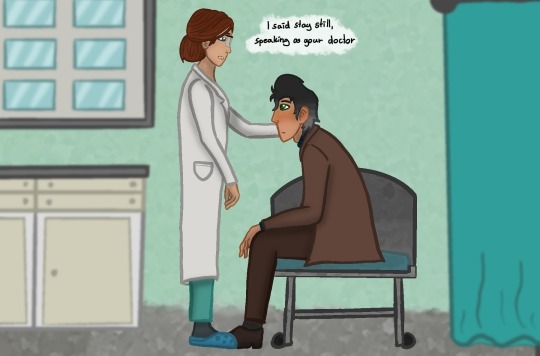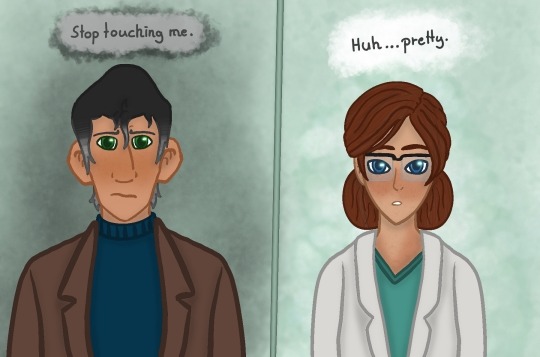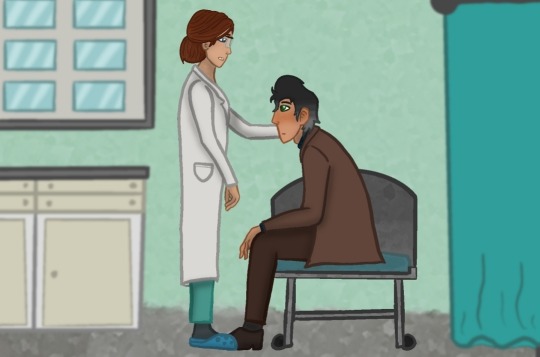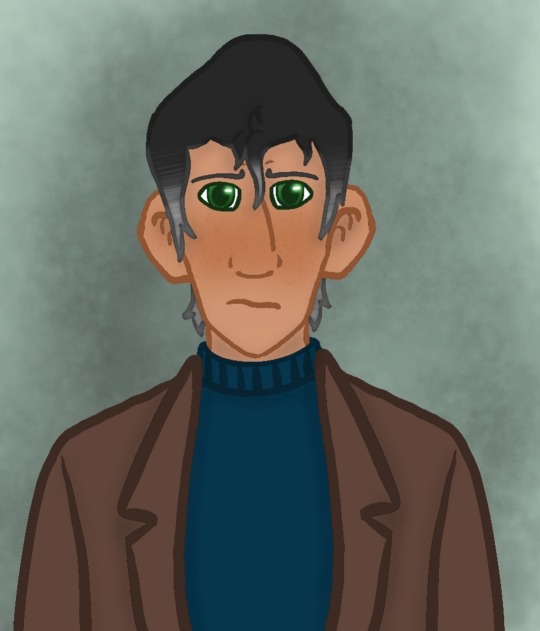#i try and try but she always looks like she was drawen when i was high-
Text
Week three of keenswimmers2023
Prompt: Childhood friend/Mysterious Stranger.
Obviously picture 2 so it's Mysterious Stranger.
Aaaannnd a fanart for Trollhunter!Strickler fanfic chapter one from @toodrasticallydumb.
Link for the chapter.
Pictures:


And without text:


Context:
Strickler got a little bit abused (not just a little bit) by Bular and straight after that he got hit by a car because this silly avocado thought it was a good Idea to walk in the middle of the street AT NIGHT. (He was messed up and didn’t know what he was doing)
He wakes up in the hospital and wants to stand up immediately but then he meets the stubborn Doctor Lake who dosen't let him do what he wants. (He dosen't know that he will marry that women-)
She holds his shoulder and puts him in place wich made him uncomfortable because he doesn't like being touched. At first she is waaayyy to mesmerized to notice but after a few seconds she pulls her hand away.
And-
NOPE. If you want to know more then...
GO AND READ IT!!!
It deserves the attention. The author is really good at writting. They're funny, nice style and most importantly good at ✨️trauma✨️
Pls, it's so damn good. Read it. Go. NOW.
Anyways-
Here are close ups:



My boy is uncomfortable but he dosen't know that he will kiss and do the forehead touch with her infront of his students-
And infront of another teacher-
They have no shame-
But they (especially him) have a lot of trauma.
Uhm...I talk to much-
#trollhunters#walter strickler#barbara lake#stricklake#toa strickler#toa trollhunters#stricklander#strickler#waltolomew stricklander#tales of arcadia#One if not my favourite fanfiction#beside heart of stone and the strawberry shortcake chronicals#anyways#I know Barbara looks off#I JUST CAN'T DRAW HER#i try and try but she always looks like she was drawen when i was high-#I am okay with pic 2 and both walters#but barb in picture one is- no.#pls ignore it#I am so sorry for this😭#love your fanfictions 🫶#I was a bit lazy with the backgrounds but I wanted to do something easy#I am already desperately trying for next week and I could off myself if I think about it#hope you like it#I habe more trauma planed after your fanart so be prepared >:)#*have#love u guys#and uhm have fun with this#as always...add anything but uhm there isn’t really anything to add since it's already at 44 chapters-#and yes ...I know I am late...but I already said last week that I probably would be-
41 notes
·
View notes
Text
‘Dark and Demon Dogs’
“Haunting the coastline from the Wash to the Deben and beyond, and inland along the Peddars Way into the Brecklands, on marshland roads and mudflats, through the Fens and into the Broads, pads the ancient terror known as Black Shuck. For many hundreds of years the legend of the ghostly black hound has been kept alive and is probably the best known of all East Anglian spectres, still appearing to people today. He is typically seen as a huge, great, black shaggy hound, with blazing red eyes and dragging rattling chains behind him, instilling terror into all he comes upon and considered a portent of impending death or doom by most. Although generally called Black Shuck, he is known by many other names too; the Galleytrot, Old Scarfe, Owd Rugman, Shug Monkey and the Hateful Thing being some, although some form of Shuck or Shuggy is most common. Nor is he always a large black hound, appearing as anything from the size of a Labrador (shrinking into a cat!), a white rabbit in Thetford, to a calf or a donkey and even a monkey on a few occasions. Sometimes he was invisible, only his fierce breath, padding feet, fearful howls or the clanking of his chains giving evidence of his presence. Sometimes he could be seen without his head, but always with his glowing eyes appearing in the middle of where his head should be. One tale from Garveston in Norfolk goes;
‘They du speak of a dog that walks regular. They call him Skeff and his eyes are as big as saucers and blaze wi' fire. He is fair as big as a small wee pony and his coat is all skeffy-like, shaggy coat across, like an old sheep. He has a lane, and a place out of which he come, and he vanish when be bev gone far enough.’
Another informant from the village of Clopton, Suffolk, reported, 'a thing with two saucer eyes', on the road to Woolpit. It would not move out of his way but grew larger and larger as it breathed: 'I shall want you within a week'. The man died the next day.
One Christmas day in the middle of the 19th. Century, Black Shuck pushed against a small, blind boy who was standing on Thetford Bridge with his older sister. The little boy plaintively asked his sister to send the big dog away, but his sister assured him that there was no dog anywhere near them. However, the terrified boy insisted that there was, and that it was trying to push him into the water to drown him. The sister then felt the poor boy being carried away from her; she realised then that what he could feel, and she could not see, must be the terrible Black Shuck that she had heard so much about. Just as her little brother was about to be pushed into the water, she dragged him back from the edge and, hand- in-hand, they rushed off back to their waiting parents at home.
Villagers in the Waveney Valley round about Geldeston call it the ‘Hateful Thing', or the 'Churchyard or Hell-beast'. One old village woman claimed that she saw it one night on the road between Gillingham and Geldeston. She tells the story in the following words;
'It was after I bad been promised to Josh that I saw the Hateful Thing. We met Mrs S. and she started to walk with us. I beard something like a dog running pit-pat-pit- pat-pit-pat. "I wonder what that dog wants", I said to Mrs S. I was walking between Josh and Mrs S. and I lay hold on Mrs S's. arm and she say "It's in front of us; look, there it be." Just in front was what looked like a big, black dog; but it wasn't a dog at all; it was the Hateful Thing and it betokened some great misfortune. It kept on until we came to the churchyard, when it went right through the wall and we saw it no more'.
In Norfolk, Neatishead Lane, near Barton Broad, is a favourite walk of Shuck, as is the cliff path from Beeston, near Sheringham to Overstrand. This recalls the old adjuration in the legend of St. Margaret;
‘Still be though still,
Poorest of all, stern one,
Nor shalt thou, Old Shuck,
Moot with me no more.
But fly, sorrowful thing,
Out of mine eyesight,
And dive thither where thou man
May damage no more.’
A more humorous tale involves the grounding of Noah's Ark on Mulbarton Common, south of Norwich. Scoffers had better not go to Mulbarton. When one village elder was heckled on the point, he replied with some heat;
‘Thass trew! Trew as I stand bere. Where else could it ba' grounded? Aren't this the highest bit o' ground for miles around? When Ole Nick see the Ark be got inter a poont (punt), an' curled his tail up under the thwart and come rowin' around jest as Noah had opened the winder to let the dove in. And Nick sings out: "Mornin' Cap'n Noah. Nice mornin'arter the rain". But ole Noah he sees Nick's tail a-curled up under the thwart an' be sings out: “I know you. You're Owd Shuck! You goo to Hell". And bangs the winder down'.
However, perhaps the most famous accounts of the legend are to be found in Holinshed's Chronicle', an ambitious history of England which was updated to include contemporary events, and a pamphlet entitled A Straunge and Terrible Wunder' written by the Rev. Abraham Fleming, Rector of St. Pancras Church. Both accounts were published in 1577, shortly after the events recorded therein. According to Holinshed's Chronicle;
‘On Sundaie the fourth of August (1577), belween the houres of none and ten of the clocke in the forenone whilest the minister was reading the second lesson in the Parish church of Bliborough (Blythburgh), a towne in Suffolke, a strange and terrible tempest of lightening and thunder strake through the wall of the same church into the ground almost a yard deepe, drave downe all the people on that side above twentie persons, then venting the wall up to the venstre, cleft the doore, and returning to the steeple, rent the timber, brake the chimes, and fled towards Bongie (Bungay), a towne six miles off. The people that were stricken downe were found groueling more than balfe an boure after.......". At Bungay the storm "wroong in sunder the wiers and wheels of the clocks, slue two men which sat in the belfrie, when the other were at the procession or suffrages and scorched an other which hardlie escaped.'
However, Fleming gives the account as starting in Bungay church and includes the infamous Black Shuck;
‘Sunday, being the fourth of this August, in ye yeer of our Lord 1577, to the amazing and singular astonishment of the present bebolders, and abhsent bearers, at a certain towne called Bungay, not past tenne miles distant from the citie of Norwiche, there fell from heaven an exceeding great and terrible tempest sodein and violent..... There were assembled at the same season, to hear divine service and common prayer, according to order, in the parish church (St. Mary's) of the said towne of Bungay, the people thereabouts inhabiting, who were witnesses of the straungeness, the rarenesse and sodenesse of the storm, consisting of rain violently falling, fearful flashes of lightning and terrible cracks of thunder, which came with such unwonted force and power, that to the perceiving of the people...the church did as it were quake and stagger, which struck into the hearts of those that were present, such a sore and sodain feare, that they were in a manner robbed of their right wits.
Immediately hereupon, there appeared in a most horrible similitude and likenesse to the congregation then and there present, a dog as they might discern it, of a black colour; at the sight whereof, together with the feareful flashes of fire which then were seene, moved such admiration in the minds of the assemblie that they thought doomes day was already come.
This black dog, or the divel in such a likenesse (God he knoweth al who worketh all), running all along down the body of the church with great swiftnesse, and incredible haste, among the people, in a visible fourm and shape, passed between two persons, as they were kneeling upon their knees, and occupied in prayer as it seemed, wrung the necks of them bothe in one instant clene backward, in somuch that even at a moment where they kneeled, they strangely died.'
After reflecting somewhat on the wrath of God, he continues;
‘There was at ye same time another wonder wrought; for the same black dog, still continuing and remaining in one and the selfsame shape, passing by another man of the congregation in the church, gave bim such a gripe on the back, that therewith all he was presently withdrawen together and strunk up, as it were a piece of lither scorched in a hot fire; or as the mouth of a purse or bag, drawen together with a string. The man albeit he was in so straunge a taking, dyed not, but as it is thonght is yet alive; whiche thing is mervalous in the eyes of men, und offereth much matter of amasing the minde.
Meanwhile, the Clerk of the church, who had gone outside to clean the guttering, was thrown to the ground during a violent clap of thunder; and at the same time, the wires and wheels of the church clock were 'wrung in sunder and broken in pieces.' Inside the church, the Curate exhorted to prayer and 'comforted the people' until the frightening manifestation of the black hound had passed away, leaving behind it marks on the stones and church door 'which are marvellously renten and torne, ye marks as it were of his clawes or talans.'
According to Fleming, next, on the same morning, in the church of Blythburgh, about twelve miles from Bungay;
'the like thing entred, in the same shape and similitude, where, placing himself upon a maine balke or beum, whereon same ye Rood did stand, sodainly he gave a swinge downe throngh ye church, and there also, as before, slew two men and a lad & burned the hand of another person that was there amang the rest of the company, of whom divers wus blustled. This mischief thus wrought, he flew with wonderful force to no litule feare of the assembly, out of the church in a hideons and bellish likeness.'
The marks of his talons, burned into the inside of the north door of the church, can still be seen today.
Interestingly, archaeologists have recently discovered the skeleton of a massive dog that would have stood 7 feet tall on its hind legs, in the ruins of Leiston Abbey in Suffolk, close to both Bungay and Blythburgh. The remains of the massive dog, which is estimated to have weighed 200 pounds, were found just a few miles from the two churches where Black Shuck killed the worshippers. It appears to have been buried in a shallow grave at precisely the same time as Shuck is said to have been on the loose in this instance.
Coming forward in time, there is a legend of a black dog too, at Blickling Hall, Norfolk. In the 19th century, alterations on the Hall were being made by Lord and Lady Lothian, by the demolition of some partitions in order to form a dining-room;
‘I wish these young people would not pull down the partitions', said an old woman in the village to the local clergyman. Why so?' 'Oh, because of the dog. Don't you know that when A. was fishing in the lake, he caught an enormous fish and that, when it was landed, a great black dog came out of its mouth? They never could get rid of that dog, who kept going round and round in circles inside the house, till they sent for a wise man from London, who opposed the straight lines of the partitions to the lines of the circles and so quieted the dog. But if these young people pull down the partitions, they will let the dog loose again, and there's not a wise man in all London could lay that dog now'.’
This tale is interesting in that it links the occurrence or appearance of the hound with a practical knowledge of geomantic function and is the only tale told of its kind, as far as I am aware. It also links the Black Dog with the liminal area of the lake, which, as we have seen earlier in the chapter, is a gateway to the Other/Underworlds, guarded by supernatural beings; it is possible that the Black Dog may be another one of these guardian entities.
The common name for the black hound, Shuck, is generally considered to derive from the Old English scucca or sceocca, which means a devil/the Devil, a demon or a goblin (the 'sc' in OE being pronounced as 'sh'). There is also the likelihood that it comes from the East Anglian dialect word 'Shucky', meaning shaggy or hairy, a marked characteristic of most descriptions of the Hound. The first known use of the term comes from the Norfolk Chronicle or Gazette, in 1805, in an account by the Rev. E.S. Taylor of Martham as follows;
‘Shuck the Dog-fiend: This phantom I have heard many persons in East Norfolk, and even Cambridgeshire, describe as having seen as a black shaggy dog, with fiery eyes, and of immense size, and who visits churchyards at midnight.’
However, the term was obviously already in use beforehand, but for how long beforehand, no one knows. In regards to the appearance of the phantom in, at or near to churchyards and graveyards, there is another old tradition that is worth noting here. It was customry in years gone by, to bury a black dog in any new graveyard, before any other burials took place. The dog was intended to act as a guardian for the dead who were laid to rest there, and to protect the entrance to the Otherworld, ensuring that none came out – or went in – that were not supposed to. This practice goes back many millennia and is still rumoured to continue today in some areas; the dog is said to be buried in the North, or North-East of the graveyard, the traditional direction of the Dead and the Underworld.
Attempts to explain the origins and nature of the Black Hound have been many, some prosaic and some fantastical. He is said to be the memory of one of Odin's battle hounds, brought over by the Viking raiders in the 9th century. Whilst this may sound appealing, Odin did not have any war or battle hounds, but was accompanied by two wolves, a description never applied to Shuck. It is possible that he is the remains of a 'fetch beast', conjured by the Norse shamans to clear the pathways for their invasions, but there is no remaining evidence for this, however attractive; but the pathways theme is pertinent and I will come back to that in a moment. In the Anglo- Saxon classic, 'Beowulf', previously referred to in the case of Grendel's Dam and the Merewives, the monster Grendel himself is termed a 'scucca' and referred to as master of the fens and moors, some of the very places said to be haunted by Black Shuck in more modern times. He is also linked in popular imagination with the Devil and witchcraft, considered to be the Devil in animal form. Whilst there are recorded cases of the Devil appearing in dog or hound form in Suffolk, the descriptions of Shuck's appearances does not seem to fit any of these. He is often linked with Churches and graveyards, as we have seen, as well as crossroads, being described as coming from, passing over or into, or finishing his perambulations at one or the other; this also links in with the fact that the most recorded instances of sightings/encounters of the hound are on paths, roads, trackways, etc. as mentioned above.
It is these latter aspects of the Black Hound that I think give us the biggest clue to his nature and function; this is either as a guardian of the 'ghost roads' - the energetic and spectral pathways across the Land that guide the spirits of the dead on their way, or lead the spirits of living witches and magical practitioners to locations of power or gatherings of their kind or as a 'psychopomp', guiding the deceased on their last journeys to the Otherworld. It has often been remarked that Black Shuck is nearly always seen walking/padding along or beside a path or trackway and that his presence either heralds or initiates a death or near death experience (sometimes also averting disaster if it is not the person's time to die). It seems highly likely that this Hound is a product of the Living Landscape, given form and function, and imbued with the energy to guard/ guide those souls in need over the liminal point between life and death that we all must pass at some point. That he is given such a form by tradition and local culture only goes to show a living tradition stretching back hundreds, if not thousands, of years, as dogs and hounds have been seen as guardians of the gates of the Underworld for millennia, particularly and especially by the succeeding cultures that have inhabited East Anglia and the rest of these Isles. That he is feared, seen as a/the Devil, shunned and reviled, is only indicative of the lack of understanding of most people of the natural Laws and Ways of the Land and their separation from them.”
—
The Devil’s Plantation:
East Anglian Lore, Witchcraft & Folk-Magic
Chapter 2: ‘Mermaids, Giants and Spectral Hounds’
by Nigel G. Pearson
#the Devil’s Plantation#nigel g. pearson#East Anglian folklore#British folklore#Celtic folklore#spectral hounds#black dogs#black shuck
64 notes
·
View notes